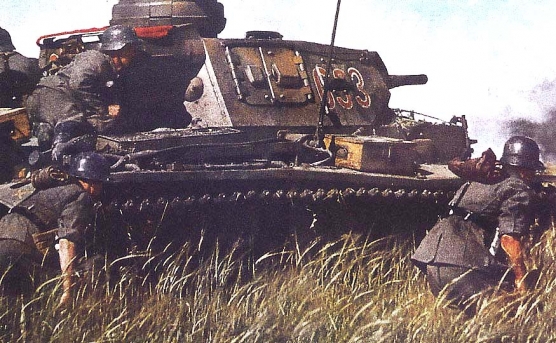|
World War Two Film Clips  The bombing of the Medieval abbey at Montecassino was one of the saddest tactical errors of the Second World War. The decision to bomb the structure was a result an error in translating an intercepted German communique that lead the Allies to believe that there was Nazi battalion contained within the abbey. This was not the case. When the Allies sifted through the rubble they were surprised to find the remains of numerous Italian civilians and very few Germans. The attached article recalls the fantastic view that was enjoyed by the assembled U.S. and British troops as the bombs fell. During the April of 1945 elements of the U.S. First Army barreled across the countryside of central Germany. Coming across the chateau outside of the Harz Mountain village of Degenershausen it must have seemed to them to be just another pretty pile of high class European rocks, just like all the other ones they'd been stumbling upon since D-Day - but they soon found that the joint was used to house many of the records of pertaining to German diplomacy between the years 1871 through 1944. This article lays bare some of the hidden details in the agreement that was struck between foreign ministers Molotov and Ribbentrop in 1939; the treaty that came to be known as the Hitler-Stalin Non-Aggression Pact.
Read about the earliest post-war sightings of Hitler: 1945-1955
George F. Earle, a former Democratic Governor of Pennsylvania, recalled his days in the White House during W.W. II when a secret German delegation came around wishing to bring an end to the war. Roosevelt rejected the conditions and Earle openly chastised him for it.
Click here to read an assessment of the late-war German soldier...
During the opening months of 1941 Nazi Germany was positively drunk with power; their army seemed able to march wherever it chose and all of Europe was trembling. Foreign correspondent for the Hearst papers, H.R. Knickerbocker (1898 – 1949), pointed out that on April 29, 1941 the Axis forces had printed, what he termed, a "trial balloon" on the pages of The Japan Times Advertiser that clearly indicated the peace terms that were acceptable to them.
Click here to read about the German concept of Blitzkrieg.
Four years of global carnage did not simply usher in an era of more destructive weaponry for the inhabitants of Earth to ponder; it also gave cause for tremendous improvements in medical care. This 1945 article anticipated a much better world that would be created from the smoldering remains of Europe and Asia - a world that was better prepared to address the health requirements of the diseased and the burned. The medical advancements that were forged between the years 1939 through 1945 saw remarkable improvements in surgery and anesthesia and brought new light on how the medical establishment understood blood and the treatment of venereal disease.
CLICK HERE... to read one man's account of his struggle with shell shock...
"The shock of modern battle is so severe to nervous systems that the hair color of thousands of young men in the Pacific and European theaters of war has turned gray overnight."
Not surprisingly, the young men in question had no interest in resembling their grandfathers
and so the services of a patriotic hair dye manu- facturing firm were secured.
Read more articles from Pathfinder Magazine...
MORE ARTICLES >>> PAGE: * 1 * 2 * 3 * 4 * 5 * 6 * 7 * 8 * 9 * 10 * 11 * 12 * 13 * 14 * 15 * 16 * 17 * 18 * 19 * 20 * 21 * 22 * 23 * > NEXT | |
|